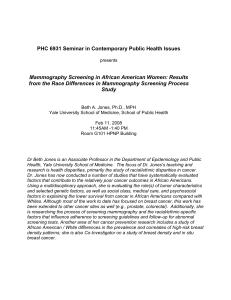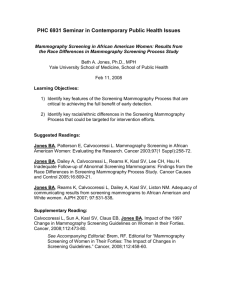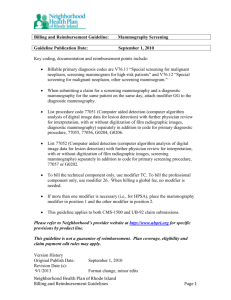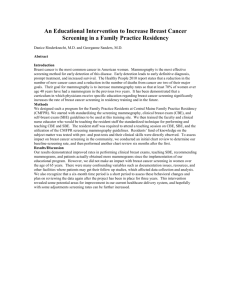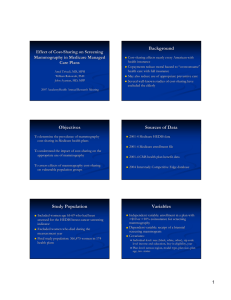Quantifying Risk and the Medical Screening Exam
advertisement
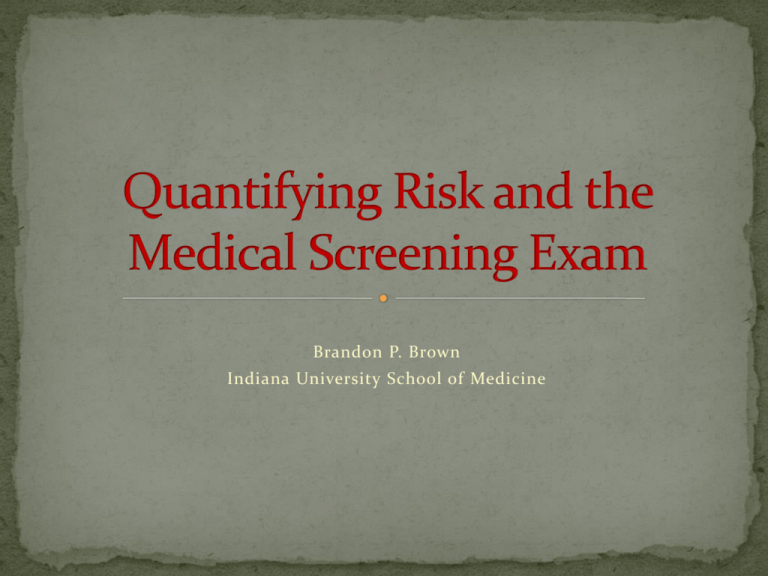
Brandon P. Brown Indiana University School of Medicine Risk as an important component in medical prevention, diagnosis, and therapy is an evolving concept Risk itself is not new, only medicine’s increasing focus on it is new For example, diabetes mellitus has been described as a high risk state rather than a true disease state Quantifying risk often involves multiple evaluations: Genetics History Physical condition Lifestyle Risk is by definition a subjective concept, yet when statistics are overemphasized in quantifying risk they give the artificial sense of objectivity Risk Stratification can become a complex issue when it is describe in the objective terms of biostatistics Framing the benefits of a screening exam in terms of relative versus absolute risk reduction can yield very different sounding results. What if a patient decides against a screening exam based on a statistical misinterpretation of the usefulness of an exam? How can we balance the concerns of public health versus personal inconvenience? Mammography This screening exam in particular is an excellent example of the dilemma facing physicians: How to communicate the concepts of risk reduction while simultaneously being fully forthcoming and also advocating for preventive health Although not always obvious, there is a tension between patient understanding and public health interests, especially when a patient or patients decide that a recommendation or preventive health measure is not in their personal best interest Mammography Several issues are at stake: How much to tell the patient regarding the specifics of risk assessment and biostatistical estimates of the benefits of screening exams? How to promote the screening exam while also presenting the patient with a choice? What to do if describing details of a screening exam actually dissuades patients from the exam? Autonomy and Beneficence: How to give the patient the greatest possible control over their health care (autonomy) How to ensure that what is medically best is done for the patient (beneficence) Although not obvious, there is a tension between patient understanding and public health interests How do we report “risk” – do patients understand what purpose mammography serves? i.e. – If we ask patients how well does mammography prevent cancer… The answer is not at all, it only helps with preventing cancer mortality In other words, patients can easily misunderstand the purpose or efficacy of the screening exam Scarce resources: not only monetary There is only limited time to be spent with any given patient, and the physician must choose how best to spend that time. If we think of time as a scarce resource in the same way that financial health care resources are scarce, this question of what to tell the patient becomes even more important. The biostatistical dilemma… Take for example a group of women ages 50-70 with average risk factors. Looking at the absolute risk of death from Breast Cancer: 8.1 in 1000 for the unscreened population 5.1 in 1000 for the screened population Absolute reduction of 3 deaths per 1000 Based on these numbers alone, mammography does not immediately strike one as very efficacious. This is partly true because the unscreened risk of death from breast cancer is not very impressive at face value. Unimpressive sounding numbers, combined with the fear many women have of the mammogram and the actual inconvenience and discomfort of the exam itself, might be enough to cause women to refuse the exam. Looking at the risk for the same populations, consider the relative risk estimates: Relative risk 8.1 per 1000 reduced to 5.1 per 1000 equals 37% reduction Screened patients are 37% less likely to die from breast cancer – relative to unscreened patients The relative risk numbers are far more convincing, but potentially more deceptive. The same exam has a risk reduction of both 3 and 37%, depending on how the information is framed. The question remains, which number should a physician quote to his patient? Which number should a physician quote to his patient? What about giving both numbers? Will this confuse patients? Perhaps both numbers should be quoted, but explaining the differences in absolute and relative risk and how these numbers are arrived at will be difficult, and all within the normal 15 minutes (at most) spent by a primary care physician talking with the patient. Is there any ethical difficulty in omitting some of the information for the sake of time or simplicity? Public Health: both risk assessments (absolute and relative) are convincing Even the absolute mortality reduction of 3/1000 makes a very big impact: In a population of 1 million people, mammography saves 3000 lives! Thus, what should determine information given or withheld from patients. Just as important, who should determine this? Do patients deserve complete (even if irrelevant or excessive) information, or should the goal be simply to encourage screening as much as possible? Does public health trump private autonomy? Imagine that a patient is indeed presented with complete and thorough information regarding the efficacy of the mammogram, and the patient decides they only need an exam once every 5 years, or even every 10 years. Is this an acceptable outcome? What if the majority of patients made such a decision? Perhaps we do our patients a disservice by focusing solely on “full disclosure” Lest we become too fixated on the autonomy of the patient and insist on always relaying every detail of our tests and decision-making process, it is a useful exercise to stop and consider just how many decisions that are made without mentioning it to the patient. To actually relay every detail of every decision, there would have to be an enormous increase in time spent. Who is this “full disclosure” truly intended to benefit – the patient, or the desire to cover our tracks? There are many types of scarce resources in medicine, and time spent with a patient must be carefully and thoughtfully used. To use this time in an attempt to preemptively defend decisions would be a true waste indeed. Caution is required to ensure that the mantra of “ethical concern” is not used as a mask for what in reality might be medico-legal fears. One bioethics expert on risk in medicine, Dr. Peter Schwartz has put it thus: “Admittedly, legal concerns may lead physicians to (fully discuss all risks) because a patient who is not tested and later develops…cancer could sue. But practicing this sort of “defensive medicine” leads to relatively irrational ways of apportioning healthcare resources, and may even injure more patients than it helps. In the end, an ideal medical system would make sure that all patients make informed decisions in such situations, but given the real limitations of the current system, a silent decision may be the ethical one.” Ultimately, it is important to be mindful that we will never be able to counsel patient on every risk, and that despite our best efforts, preventive medicine will always be incomplete and thus leave room for therapeutic medicine. If (and it is a big “if”) concerns over medico-legal issues and the expectations of our peers can be placed secondary to concern for the immediate patient at hand, risk and prevention can be useful assistants in our medical efforts and avoid a fate as reflexive check-boxes in an algorithm that sees only one kind of patient. Of course, there are many other examples of screening exams, including prostate tests, colonography, CT colonography, and chest CT, and these deserve equal scrutiny, likely involving similar dilemmas of public health and patient information. The use of mammography merely serves as a case in point regarding what is a broader issue. Chamot E, Perneger TV. Misconceptions about efficacy of mammography screening: a public health dilemma. Journal of Epidemiology and Community Health 2001;55(11):799-803. Domenighetti G, D'Avanzo B, Egger M, Berrino F, Perneger T, Mosconi P, et al. Women's perception of the benefits of mammography screening: population-based survey in four countries. International Journal of Epidemiology 2003;32(5):816-21. Schwartz PH. 2007. Silence about Screening. American Journal of Bioethics 2007;7(7): 46-48. Slaytor EK, Ward JE. How risks of breast cancer and benefits of screening are communicated to women: analysis of 58 pamphlets. BMJ 1998;317(7153):263-264. Thomson R, Edwards A, Grey J. Risk communication in the clinical consultation. Clinical Medicine 2005;5(5):465-9. Thornton H, Edwards A, Baum M. Women need better information about routine mammography. BMJ 2003;327(7406):101-103. U.S. Preventive Serves Task Force. 2002. What’s new from the U.S. Preventive Services Task Force: An overview of recommendations: Screening for prostate cancer. AHRQ Publication No. APPIP03-0003. Available online at http://www.ahrq.gov/clinic/3rduspstf/prostatescr/prostatwh.pdf Whitney SN and LB McCullough. Physicians’ silent decisions: Because patient autonomy does not always come first. American Journal of Bioethics 2007;7(7): 33–38. *I owe most of the ideas in this presentation to discussions with Dr. Peter Schwartz of the IU Center for Bioethics. His ongoing original work in this area has resulted in increasing awareness of the many concerns regarding screening exams.
